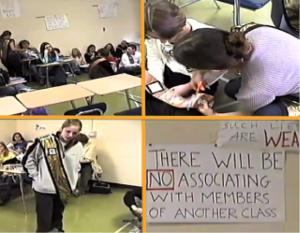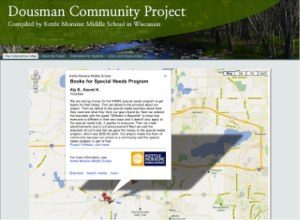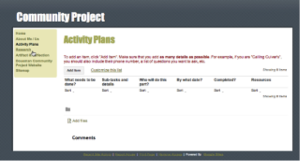McREL has long maintained that technology, when used thoughtfully and intentionally, enhances good instruction. But it’s not about the technology itself; it’s about technology working together with a well-designed lesson or project focused on clear learning targets and differentiated by student needs and learning styles.
I just read a blog post by Krista Moroder, an educator in Wisconsin, and it really resonated with me. Krista’s reflections, posted at EdTechCoaching, help us remember that good teaching isn’t something new, created by modern technology tools. Many of us got into education because of great teachers in our own past. Technology can, however, make good instruction even better.
With her permission, I’ve reposted Krista’s column below.
-Howard Pitler
Authentic, Personalized Learning: Pre- and Post-Technology (A Case Study)
by Krista Moroder
I recently worked with a few teachers on a service-learning project they had designed for their students. As we talked about the purpose and design of the project, I was brought back to my sophomore year of high school–and one of the school assignments that had a huge impact on who I am today.
I was fifteen, and I had just read Martin Luther King, Jr.’s “I Have a Dream” speech. In response to the reading, we were told to try to fix an injustice in our community. I ended up starting an informal community service
organization (“T.H.E. Group- Teens Helping Elderly”)–and set up a few volunteer commitments. After the school assignment ended, however, the phone calls kept coming in–so I kept the project going for the next few years.
By the time I graduated, over one hundred of my peers had helped out in some way: we raked leaves, cleaned out refrigerators, and vacuumed rooms. Mostly, however, we just spent time sitting and talking with the residents we volunteered to help. At the time, I thought I was helping them–and it wasn’t until years later that I realized how much they had helped me. In a lot of ways, those conversations grounded me.
***
At every education technology conference I’ve been to in the last year, I’ve seen images similar to the one to the right–suggesting that all learning before the digital age was lecture-based and routine. This was not what I experienced.

What I remember from my high school experience was no different. Two of the best teachers I had were my English teachers (no doubt the reason I chose to teach English), and they were fantastic at building assessments that didn’t feel like assessments.
They could have asked us to do a multiple choice test in response to Martin Luther King, Jr.’s speech. Instead, they gave us the opportunity to make an actual impact–to do something real.

When we read George Orwell’s 1984, we studied the theme of government repression and developed our own responses. My group took over the classroom for a week and created our own version of the Stanford Prison Experiment. We closely examined our peers throughout the week and reported our conclusions in a final analysis. Another group printed out every page of the Patriot Act, completely covered all four walls with paper (the policy was that extensive) and drew our attention to a few key features.
Our two groups ended up with completely different responses–neither of which could have been reported on the same standardized test. We still met the same benchmarks. We were just given a choice in how we met them.
I don’t remember staring blankly at a wall because I didn’t have a laptop to engage me. I remember thoughtful and passionate discussions… I remember connecting with the people around me…I remember building products out of
ideas… and I remember relationships.
***
Let’s take a look at the “Justice Project” I did in high school, and the “Community Project” that the middle school students in my current district worked on. These projects were virtually the same, and their effectiveness had almost everything to do with their design. In each project, the audience was authentic, the topic was relevant, and the student had ownership in how they demonstrated their learning.
What changed was the tools that these students had available to them, and the efficiencies they provided.
1. Today, we can organize content more effectively.
Then–I shuffled between papers, journal entries, books, and bookmarked links.
Now–Students can use a website template that the teacher has created to store all of their content.
2. Today, we can provide more access to our work.
Then–My teacher had to physically collect our journals and papers to follow our progress.
Now–Students can share their digital portfolios with their teachers, so teachers can check their progress at any time.
3. Today, we can collaborate more efficiently.
Then–If we needed to meet as a group, we had to coordinate our sports/work/club schedules so that we
could work on the same computer.

4. Today, we can automate rote tasks and provide faster feedback.
Then–I would take short quizzes on paper and wait 1-2 days to receive feedback.
Now–Students take quizzes online and receive immediate feedback; teachers can spend time focusing on higher-order tasks.
5. Today, we can find information more quickly.
Then–I had to search through a book or find someone who knew the answer.
Now–Google.
6. Today, we can provide a wider audience for students.
Then–My audience was usually just my teacher or my classmates.
Now–Students can publish their projects to a website that the entire community can access; stakes are
higher.
***
When we compare both of these projects, the real reason for integrating technology becomes apparent: it is simply about being more efficient and productive. Student engagement isn’t reliant on an iPad app–it is reliant on a teachers’ ability to create authentic, personalized learning experiences, like the service learning project I was part of years ago and our students are part of today.
Building these experiences for students requires creativity, organization, project management skills, and a deep understanding of backwards design.
Being efficient requires knowing how to use the technology that is currently available to us.
We need to do be able to do both.


This article makes some excellent points that tend to go against popular thought in education: that computer and other new technology is a tool that should be used appropriately. Many of us have probably seen an educator who has fallen in love with a specific technology and tries to use it in every lesson whether appropriate or not for that particular use. That does not make the classroom more efficient.
Not that efficiency is necessarily the focus for classroom activity. However, if we can use technology, as noted in the article, to make the repetitive tasks less so, then we can devote more time to the task of presenting situations where the students can increase their knowledge.
The ‘wow’ factor of technology may work to increase engagement, however, students can see through the curtains at the Great Oz, and tend to ignore the directions, just as Dorothy did in Baum’s classic.
I love that technology has made it so that we can reach individual student needs. My students are no longer a “group” that I am throwing information at. They are now individuals, and as individuals I can reach their individual needs with the assistance of technology.
This article is very refreshing to read. I have been an educator for 10 years and a mother for nineteen. My oldest son has struggled with school throughout his entire experience. He didn’t struggle in that he wasn’t smart enough, instead he struggled with the opposite of being too smart and bored at every school that we tried. We tried private, public, and then charter and while the charter was the closest to meeting his needs, it was just satisfactorily and still didn’t push him to his fullest potential.
I see the same thing happening with my eleven year old now. He is one of these “21st century” kids; he has his own website, youtube channel, and blog. He manages his own Minecraft server, sets his rules and administrators, programs mods, and so much more. This kid loves technology! However, when he goes to school, rarely does he get to use these skills. He is presented worksheet after worksheet and thus spends most of his time daydreaming.
As a teacher, while I was very passionate about technology in the classroom, most were not. This is a shame. Some teachers did begin to use technology but their idea was that if they had this piece of technology or device, then their classroom would be amazing. As we read above, technology isn’t the key. It does need to have excellent pedagogy and then placing the tools to enhance it!
My point is, without good pedagogy and technology, then we are short changing out students and not preparing them for the real world they will experience when they grow up!